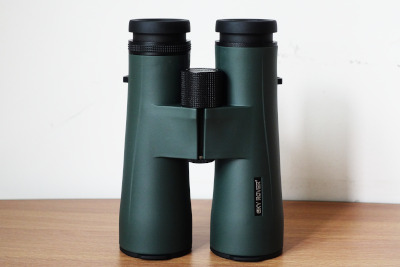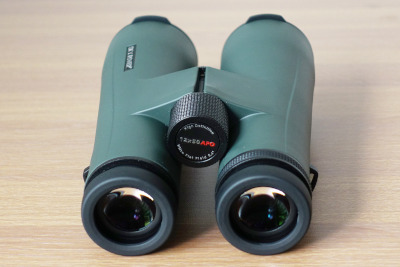

The United Optics (UO) Sky Rover Banner Cloud APO is a new series
of high performance roof prism binoculars made in Kunming (China).
In March/April 2024 I had the opportunity to field-test a
pre-production sample of the 12x50 version, and my impressions
are summarized in the present report. Unfortunately, the weather
conditions were not favorable for critical astronomical observations,
but at least they allowed for a little bit of star testing. Most
observations were carried out during daytime under varying ambient
light.
Fig. 1: The UO 12x50 Sky Rover (Banner Cloud) APO, a wide angle binocular with a very well corrected image
Fig. 2: Left: The eyecups are of metal and firmly lock into 6 distance settings. Center: Eye-lenses are huge for a panoramic view. Right: Several baffles are installed in front of the prism entrance to catch stray light.
Fig. 3: Left: A view through the objective displays a neutral color rendition. Center: Two prism leaks surround the exit pupil, but seem sufficiently far from the eye-pupil to remain harmless (see update below). Right: The off-centered 'edge-pupil' shows a moderate degree of vignetting.
The following table summarizes some of the specifications of the instrument:
| Real angle | Apparent angle | Eye relief | Exit pupil | Close focus | Weight(*) | |
| of field (deg) | of field (deg) | (mm) | diam. (mm) | (m) | (gram) | |
| 12x50 APO | 6.4 | 71.4 | 18 | 4.2 | ~3 | 1060 |
The image is bright, with high contrast and color saturation. UO specifies the transmission as 92%, and I had a modern Leica 7x35 Trinovid for comparison. The Trinovid is a completely different animal, but in terms of color rendition and brightness during daylight observations both binoculars showed quite a few similarities. The Sky Rover thus renders colors somewhat warmer than, for example, a Zeiss SF or even a Swarovski EL. The stray light suppression is working well and I hardly had the experience of bad glare during my tests, unless the direction of view was dangerously close to the sun. There are two prism-leaks visible at a certain distance to the exit pupil, but I haven't experienced any situation in which light from these leaks have accidentally entered the eye (see update below for further information). Chromatic aberration in terms of color fringes are very well suppressed in the Sky Rover, which in this aspect is far superior to the Leica (the latter admittedly being a particularly bad example when it comes to CA control). In the night and at bright light sources, the Sky Rover exhibited the usual spikes which are generated by diffraction at the roof edge. Here, the Trinovid scored slightly better, but in no situation any of these spikes would become visible on objects of the night sky. Pincushion distortion is visible but low with the Sky Rover, and during panning I observed a residual globe effect. This impression is known to be rather subjective and may vary from person to person.
The eyecups are made of metal, are removable and lock firmly into six different positions, although the uppermost two settings were obsolete for my individual facial anatomic features. The eye relief of 18 mm was just barely sufficent to cover the entire field with my sunglasses on, when the eyecups were fully turned down. In bright daylight I sometimes found a precise setting of the eyecups mandatory to avoid unwanted effects such as floating shadows - a well known problem whenever moderately narrow exit pupils meet narrow eye pupils while the angle of view is as wide as with this binocular. The size of the 'eyebox', means the abstract space of positions and angles in which a perfect match between exit pupil and eye pupil is granted, is necessarily limited here. This is why I generally prefer binoculars with larger exit pupils even during daytime observations, as soon as the subjective angle significantly exceeds 60 deg.
The overall built of this binocular, the housing of which is made of die-cast Magnesium, appears tough and solid, though evidently I haven't been able to test that. The binocular is specified to be water resistant for 30 minutes while submersed under 1 m water, and the operational temperature range is supposed to cover -20 deg. C to 55 deg. C. The objective covers sit firmly, as does the eyepiece rainguard.
Fig. 4: Left: A look into the (right tube's) eyepiece using a closeup lens for more detail shows that the 'prism leaks' are just reflections on two screws. Right: That's me at the United Optics plant, trying to explain the advantages of Porro II prisms (photo by Mr. Wong).
The 'prism leaks' have turned out to be no leaks at all but reflections of light on two screws. The light which is seen here enters from the eyepiece side - that is why during observations, when the eyepieces are covered by the face, these reflections do not occur and the entire phenomenon is harmless. Sky Rover may apply some black paint to eliminate this cosmetic problem.
I just had the opportunity to visit the factory in Kunming and to inspect the entire series of Banner Cloud binoculars. There was no time for detailed tests, but it appears that all models share the same characteristics and that they will offer a similarly high performance level as the 12x50. Personally, I like the 10x50 most, since it is as impressive as the 12x50 but with larger exit pupils, thus with a more relaxed ease of view, and of course easier to hold steady.
Last modified: April 2024